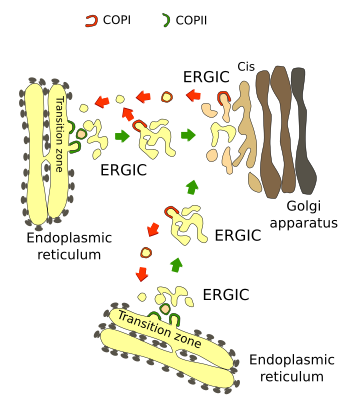The endoplasmic reticulum mostly communicates with the Golgi apparatus by vesicular trafficking. Most proteins and lipids leaving the endoplasmic reticulum are enclosed in vesicles or are components of the vesicular membrane. The vesicles are formed in specialized regions known as exit zones (Figure 1).

COPII proteins are involved in the formation of vesicles in the endoplasmic reticulum. They are assembled in the exit zones and perform two functions: vesicle formation and cargo selection. These cargoes are proteins to be included and transported in the vesicle.
COPII vesicles lose part of their protein coat and fuse to one another to form the ERGIC (endoplasmic reticulum-Golgi intermediate compartment). It is a tubule-vesicular compartment that is moved toward the cis domain of the Golgi apparatus by motor proteins and microtubules (cytoskeleton components). Then, the ERGIC becomes cis domain cisterns (Figure 1).
During this process, in the ERGIC and Golgi apparatus, other vesicles are formed. These are the COPI coated vesicles, which select cargoes to be transported back to the endoplasmic reticulum. It is a recycling pathway that brings back proteins that escaped from the endoplasmic reticulum into COPII vesicles. These proteins actually perform their function in the endoplasmic reticulum and are known as resident proteins.
KDEL receptors are involved in the recognition and selection of resident proteins to be included in COPI vesicles. KDEL receptors travel back to the endoplasmic reticulum and release the cargoes. Then, KDEL receptors are included in COPII vesicles and transported to the ERGIC-Golgi apparatus. Thus, KDEL receptors alternate between the endoplasmic reticulum and the ERGIC-Golgi apparatus, bringing back resident proteins. The mechanism for binding a cargo in one organelle and releasing it in the other is based on the pH differences between both compartments. The pH is more basic in the endoplasmic reticulum than in the ERGIC-Golgi apparatus. The affinity of KDEL for its cargoes is higher in basic environments (binds the cargo) and lower in acid ones (releases the cargo).
-
Bibliography ↷
-
Bibliography
Antonny B, Schekman R. 2001. ER export: public transportation by the COPII coach. Current opinion in cell biology. 13:438-443.
Barlow C, Helenius A. 2016. Cargo capture and bulk flow in the early secretory pathway. Annual review of cell and developmental biology. 32: 197-222.
Saito K, Maeda M, Katada T. 2017. Regulation of the Sar1 GTPase cycle is necessary for large cargo secretion from the endoplasmic reticulum. Frontiers in cell and development biology. 5: 75.
Zanetti G, Pahuja KB, Studer S, Shim S, Schekman R. 2012. COPII and the regulation of protein sorting in mammals. Nature cell biology. 14: 20-28.
-
 Endoplasmic reticulum
Endoplasmic reticulum 